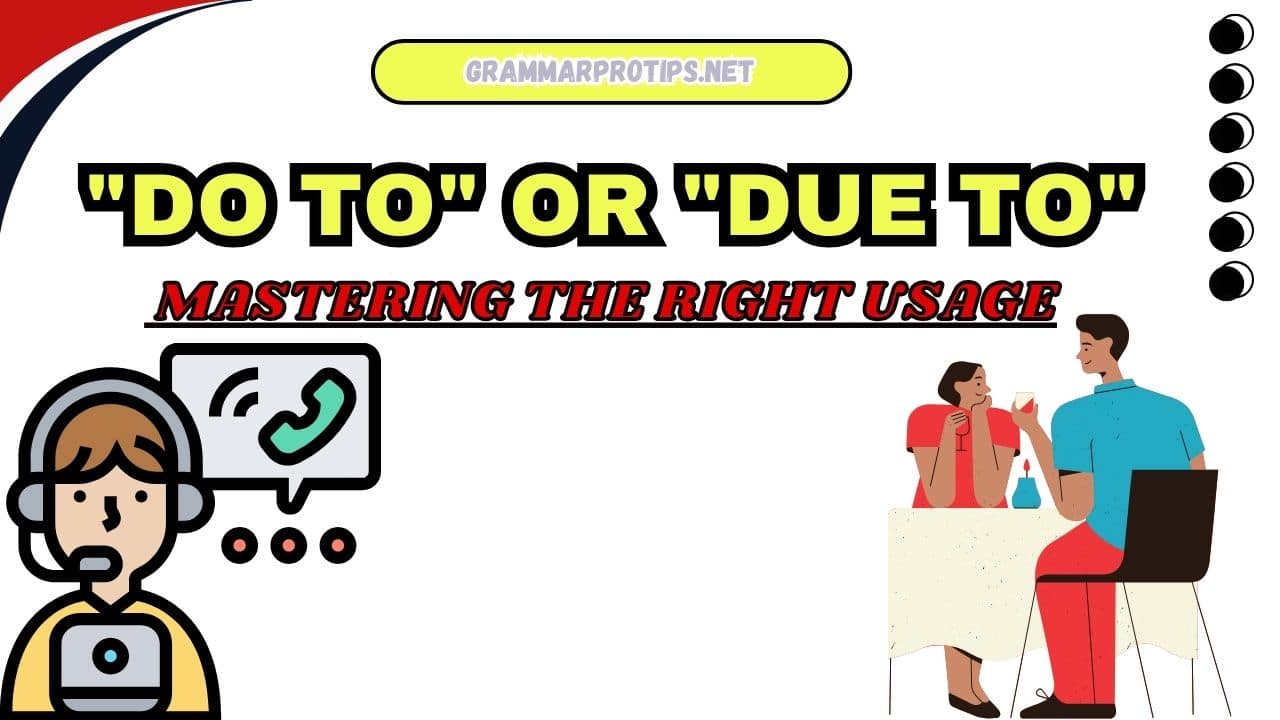In the world of writing, one of the most common issues English speakers face is the confusion between “do to” and “due to”.
While these phrases may sound similar, their usage, meanings, and contexts are different. Mastering the correct usage of each will ensure that your writing is both clear and effective, especially in professional communication and formal writing.
In this article, we’ll explore the proper contexts for using “do to” and “due to”, highlighting common grammar mistakes, providing examples, and explaining how to use each phrase effectively.
By the end, you’ll have a clearer understanding of when to use each and how to avoid common misconceptions.
What Is “Due To”?
“Due to” is typically used to indicate cause or reason. It functions as a prepositional phrase and is often used to explain why something happened or will happen.
It’s very common in formal writing, such as business emails or official reports.
Correct Usage of “Due To”
“Due to” usually modifies a noun and explains the reason behind an event or condition.
Example Sentences:
- “The flight was delayed due to inclement weather.”
- Reason: Inclement weather caused the delay.
- “The meeting was rescheduled due to unforeseen circumstances.”
- Reason: Unforeseen circumstances led to the change.
In these examples, “due to” is properly explaining the cause behind the event.
Common Misconceptions about “Due To”
One mistake people often make is using “due to” incorrectly, especially when it doesn’t follow the appropriate syntax.
For example:
- Incorrect: “The meeting was delayed due to the fact that the weather was bad.”
- Corrected: “The meeting was delayed due to bad weather.”
In the first sentence, “due to the fact that” is redundant and can be simplified to just “due to.” Avoid this overly wordy phrasing in most cases to make your writing more concise.
Using “Due To” in Emails
Let’s look at how “due to” might be used in a professional email:
Email Example:
Subject: Meeting Delay
Dear John,
I wanted to inform you that the meeting scheduled for 10:00 AM will be delayed due to a technical issue with the video conferencing software. I will keep you updated on the new timing.
Best regards,
Sophia
In this example, “due to” is used to provide the reason for the delay in the meeting. This is a typical scenario in professional communication.
What Is “Do To”?
On the other hand, “do to” is much rarer and refers to an action being performed on someone or something. It’s typically found in more informal contexts.
It is less common in formal writing and often occurs in more casual, everyday language.
Correct Usage of “Do To”
“Do to” can describe an action that affects someone or something, though it’s not used as frequently.
It’s also used in some informal or conversational contexts to explain what an action does or how it impacts a person or situation.
Example Sentences:
- “The changes you made to the website really did to improve its overall look.”
- This sentence indicates that the action of making changes improved the website’s design.
Common Confusion Between “Do To” and “Do Too”
Another common issue is confusing “do to” with “do too”. While “do to” describes the effect of an action, “do too” is used to mean “also” or “as well.”
- “I’ll go to the event, and you do too.”
- Here, “do too” means “you also go.“
Be cautious about this, as the wrong usage can lead to confusion.
Examples: “Do To” vs “Due To”
The difference between “do to” and “due to” becomes more apparent when looking at sentence structure. “Due to” is used to explain causality, whereas “do to” involves actions that have an impact.
| Sentence Type | Example Using “Due To” | Example Using “Do To” |
|---|---|---|
| Explanation of Reason | The flight was delayed due to bad weather. | The delays were do to the disruptions in the system. |
| Casual Impact of Action | The change in policy was due to customer feedback. | The new policies did to help improve service quality. |
| Formal Writing | The event was postponed due to a scheduling conflict. | N/A – Rarely used in formal writing |
| Professional Communication | The project deadline was extended due to the team’s efforts. | N/A – Rarely used in professional communication |
By referring to this table, you can see the distinction in context and syntax between these two expressions.
Common Grammar Mistakes to Avoid
1. Using “Due to” After a Verb
One of the most common grammar mistakes is using “due to” incorrectly, often after a verb. For example:
- Incorrect: “The meeting was delayed due to I was sick.”
- Correct: “The meeting was delayed due to my illness.”
“Due to” should always be used to modify a noun or noun phrase, never after a verb.
2. Confusing “Do To” with “Due To”
People often mix up “do to” and “due to”, especially in spoken English. However, “due to” is used for reasons or causes, while “do to” reflects the effect of an action.
For example, saying “The delay is due to the technician doing to the equipment” is incorrect. Instead, say “The delay is due to the technician’s work on the equipment.”
Improving Your Grammar: Key Takeaways
To improve your grammar, keep these rules in mind:
- “Due to” explains the cause or reason and is used with nouns or noun phrases.
- “Do to” indicates an action affecting something or someone, though it’s less common and more informal.
- Avoid the phrase “due to the fact that” for conciseness just say “due to”.
- Use grammar tools or online writing assistance to spot errors and improve your sentence structure.
How to Use Alternatives to “Due To”
If you’re looking for a less formal or redundant way to express the same idea, here are a few alternative expressions:
- “Because of”
- “Owing to”
- “As a result of”
These phrases can help diversify your writing and make it sound more natural without losing meaning.
Example Alternatives:
- “The event was canceled because of unforeseen circumstances.”
- “The delay was owing to a technical glitch.”
These alternatives can help your writing feel fresher and less repetitive.
Conclusion: Mastering the Difference
Both “do to” and “due to” serve different purposes, and understanding how to use them properly will improve the clarity and professionalism of your writing.
While “due to” is a standard phrase for explaining reasons and causes, “do to” is rarely used and should be reserved for informal contexts.
In formal writing or professional communication, the key is to use “due to” for causality, avoiding the overcomplicated use of “due to the fact that.”
As always, pay attention to common grammar mistakes and refine your writing style by practicing proper syntax.
By familiarizing yourself with these rules, you’ll be able to confidently improve your grammar and enhance your writing style in any context whether you’re writing a professional email, crafting a report, or simply communicating with colleagues.
Read more knowledgeable blogs on Grammar Pro Tips

Sienna Mauldon is a passionate writer and grammar expert. On her blog, she shares easy-to-follow guides to help readers master grammar rules and improve their writing. With a love for language and teaching, Sienna makes grammar simple and fun for everyone, from beginners to experienced writers.








